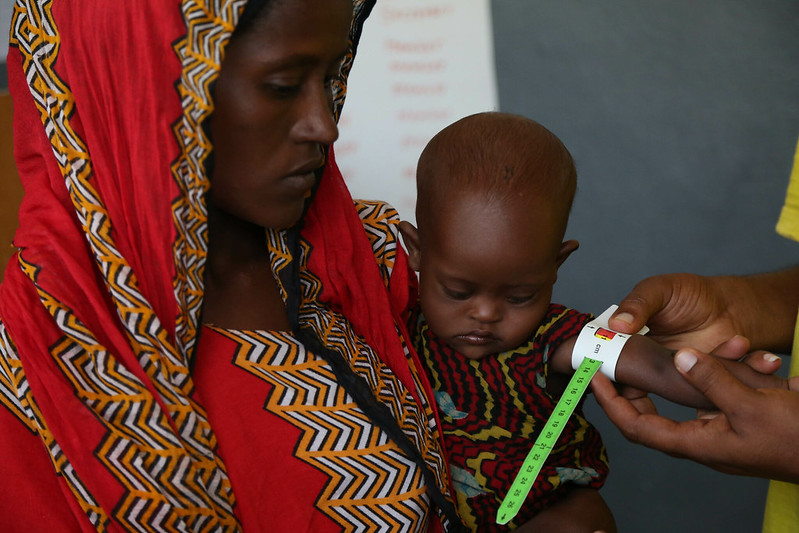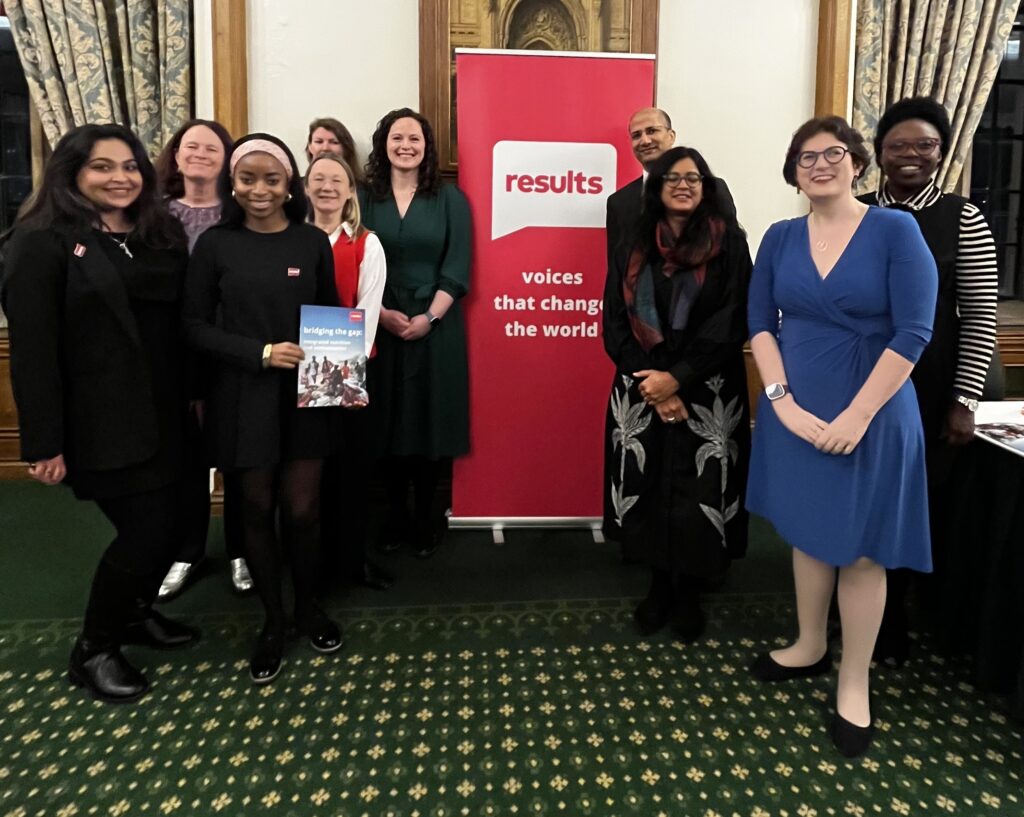Nutrition and immunisation: towards an integrated future

Immunisation and nutrition integration (INI) was a prominent theme at the Nutrition for Growth Summit in Paris last week. What is it, and why do we think it is an important advocacy opportunity to increase spending on nutrition programmes?
In Bridging the Gap: integrated immunisation and nutrition we describe what INI looks like to a parent who wants to get their child vaccinated.
“Today, a mother will walk into a health clinic carrying an unvaccinated 18-month-old. A nurse will be waiting, holding a multi-coloured tape, ready to measure the child’s upper right arm. Nearby, a fridge holds vaccines, and a computer is on, ready to log this child’s first-ever medical record. Once the tape is wrapped around the child’s arm, the arrow points to red. The final number reads 9.5 cm. The mother’s worst fears are confirmed: her daughter is malnourished. But alongside those fears, there is hope. Her child can be helped. Today, she will receive nutritional supplements to strengthen her body, and she will begin an essential immunisation program.”
There are three very broad reasons why Results UK is so passionate about integration. The first is who we are as an organisation, the second is the type of innovative, flexible and community-led development that integration represents and thirdly (and arguably most importantly) it is an approach which we believe we can persuade countries like the UK to fund because it helps them to meet their own policy priorities.
Results UK is an advocacy organisation that exists to end poverty. At the top level we see that there are three key elements we all need to get out of poverty – health, education and economic opportunity. Improving access to any one of these three areas is a good thing in its own right, but ending poverty requires all three. So we are always trying to demonstrate the benefits and impact of integrating different policy areas.
Last week at N4G we launched the second in our series of ‘Good News on Nutrition’ briefings; this one is on integration. Specifically, it highlights an INI programme in Uganda and an integrated home-grown school feeding programme Nigeria demonstrating what integration in nutrition can look like beyond vaccination and the first 1000 days of a child’s life.
Another reason why we are so passionate about integration is what we call citizen voice but could also be described as a human rights-based approach. Community engagement in designing advocacy strategies and service delivery programmes is fundamental to how we see international development. INI approaches are community shaped and led. These initiatives can and do look different in different countries and regions but all aim to achieve the same goals – increasing vaccinations rates and ending malnutrition. We believe that this is morally and ethically the right thing to do but it is also really important from an advocacy perspective.

We all know that this is a difficult financial and political environment for international development. Spending on ODA in the UK has recently been cut again – this time to 0.3% of GNI down from the legal obligation of 0.7%. Last week’s Spring Statement made it clear just how quickly those cuts are going to bite. Whilst we are of course campaigning against these cuts, we also have to recognise the reality of where we are.
As advocates who want to increase spending on nutrition, we have to be able to demonstrate impact, cost effectiveness, sustainability and that these programmes can help to deliver national policy priorities such as improving outcomes for women and girls. INI is a really good example of how we can do just that.
Firstly, while it is necessary to invest in integrated planning and to upskill community healthcare workers, integrating services can reduce duplication, optimise resources, and lower overall healthcare costs. Programmes that can improve outcomes and save money are very attractive to donors in these challenging circumstances.
Secondly, In regions where health systems are fragmented due to instability, integrating services provides a practical and effective solution. By combining nutrition and immunisation, communities living in fragile settings would benefit from fewer visits, more coordinated health campaigns, and potentially safer, more consistent service delivery.
Thirdly, integrated services can reduce the caregiving burden on women while improving the health of mothers and adolescent girls. Addressing malnutrition in women and girls is essential, and it has significant intergenerational impacts.
While the UK Government did not make a financial pledge at N4G this year, it did launch a policy initiative on integrating nutrition more broadly into development programming. This is a clear indication that there are advocacy opportunities for us to prioritise nutrition even in the current constrained fiscal environment.
So what are our top level asks of the UK Government on integration?
- 1. Provide financial support for integrated nutrition and immunisation programs
Advocate for UK government funding to support global health programmes that integrate nutrition and immunisation services, with a focus on low- and middle-income countries (LMICs).
- 2. Build the evidence base and utilise the outcomes
Promote and fund research into Integrated Nutrition and Immunisation (INI) by supporting pilot programmes. Celebrate successful new models of development funding and partnership working embodied in INI. Use the evidence generated to scale up successful models and expedite integration efforts.
- 3. Contribute to the successful resourcing of key partners
Advocate for strong UK contributions to international partners like Gavi, the Vaccine Alliance who can support collaboration and integration of nutrition and immunisation efforts.
In advocacy we often focus on the next ask we have of governments – whether that is money or legislative change. However we also need to focus on accountability, whether this is for a financial pledge that they have made or a commitment to an approach like integration. We have to make sure that integration in practice is the same kind of high quality, community-led programming featured in our case studies. Our advocacy needs to ensure both that nutrition programmes are funded and that they are high-quality interventions that help build health systems. We can’t allow integration – a concept that holds so much hope and potential to save lives – to become a euphemism for cost cutting.
